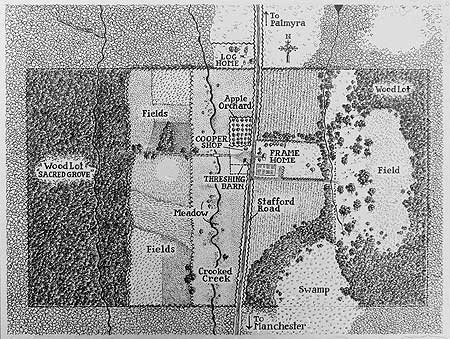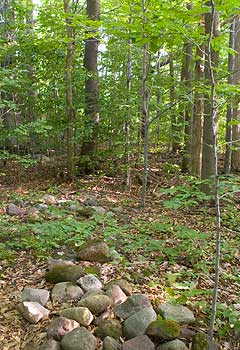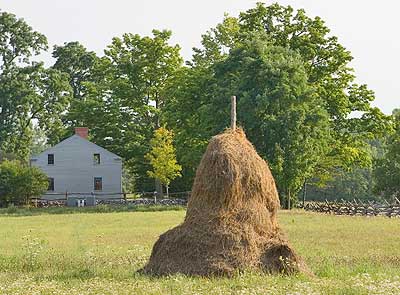The Smith Farm
The Smith family selected a 100-acre tract of good farmland and developed the property with hard work. The land featured gentle sloping hills and a slow, meandering, year round stream called Crooked Creek, which originated near the Hill Cumorah. The property was forested with mature sugar maple trees as well as beech, oak, and other hardwoods. Initially they began clearing the heavily forested land. They felled several thousand trees, some more than 100 feet tall with diameters up to four feet. The trees were used for construction timbers, fence rails, or firewood. Excess wood was burned and the ashes were sold.
 |
One of the trail markers showing the Smith farm. |
"We cleared sixty acres of the heaviest timber I ever saw. We had a good place. We also had on it from twelve to fifteen hundred sugar trees. . . . We worked hard to clear our place.
–William Smith
In order to plant crops, they also removed the underbrush and large rocks. The stones were stacked to mark the 1.66-mile boundary of their property and served as a stone base over which they would construct fences. A variety of fences were built using thousands of split rails to keep their property free from wandering livestock
The cleared fields were used to plant grains such as wheat, barley, rye, corn, buckwheat, and oats. Smaller gardens on the property included potatoes, carrots, beets, turnips, beans, pumpkins, squash, and flax. These harvests fed the family, the livestock, and the remainder was sold at market. Flax was spun into cloth, used for curtains, and became another item to sell. The Smith's also planted and fenced an apple orchard containing a variety of apples from about 36 trees.
 |
| This picture shows some of the remnants of an old stone fence on the Smith farm. |
The meadows on the property were mowed one or twice each season and were commonly set aside for winter grazing. The Smiths caught fish in Crooked Creek and small game from the swamp area. The pelts were bartered or sold in town. The swamp also provided cattails that were used as gasket materials for lids of barrels that the family made in their cooper shop.
Stafford Road cut right through their property as a rutted, ungraded wagon trail. Traveling distances were about two miles north to Palmyra village, and six miles south to Manchester village. The Smith family's granary, cooper shop, and log and frame home bordered Stafford Road and would have been conveniently located for doing business or taking things to and from market. By 1830, the twelve years of labor on the 100-acre property had turned the forested land into a quality self-sufficient farm produced by their family unity, thrift, and hard work.
